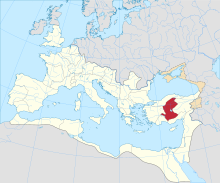Galatia (Roman province)
This article needs additional citations for verification. (April 2016) |
| Provincia Galatia Ἐπαρχία Γαλατίας | |||||||||
|---|---|---|---|---|---|---|---|---|---|
| Province of the Roman Empire | |||||||||
| 25 BC–7th Century | |||||||||
 | |||||||||
| Capital | Ancyra | ||||||||
| Historical era | Classical Antiquity | ||||||||
• Annexation by Augustus | 25 BC | ||||||||
• Theme of Thrace established | 7th Century | ||||||||
| |||||||||
| Today part of | |||||||||

Galatia was the name of a province of the Roman Empire in Anatolia (modern central Turkey). It was established by the first emperor, Augustus (sole rule 30 BC - 14 AD), in 25 BC, covering most of formerly independent Celtic Galatia, with its capital at Ancyra.
Under the reforms of Diocletian, its northern and southern parts were split off to form the southern part of the province of Paphlagonia and the province of Lycaonia, respectively. In ca. 398, during the reign of Arcadius, it was divided in two provinces, Galatia Prima and Galatia Secunda or Salutaris. Galatia Prima covered the northeastern part of the old province, retaining Ancyra as its capital, and was headed by a consularis, while Salutaris comprised the southwestern half of the old province, and was headed by a praeses with seat at Pessinus. Both provinces were part of the Diocese of Pontus. The two provinces were briefly reunited in 536-548 under Justinian I. Although the area was eventually incorporated in the new thema of Anatolikon in the latter half of the 7th century, traces of the old provincial administration survived until the early 8th century.
Episcopal sees
Ancient episcopal sees of the Roman province of Galatia Prima listed in the Annuario Pontificio as titular sees:[1]
Ancient episcopal sees of the Roman province of Galatia Secunda listed in the Annuario Pontificio as titular sees:[1]
Administrators
- Publius Juventius Celsus 25 BC
- Publius Sulpicius Quirinius 11 BC
- Marcus Plautius Silvanus 6/7
- Marcus Annius Afrinus 49-54
- Gnaeus Pompeius Collega 74/75 - 76
- Marcus Hirrius Fronto Neratius Pansa 77-80
- Tiberius Iulius Candidus Marius Celsus 87-88 - 91-92
- Lucius Antistius Rusticus 93-94
- Titus Pomponius Bassus 94-101
- Gaius Iulius Quadratus Bassus 107-112
- Gaius Trebius Sergianus 129
- Publius Juventius Celsus 161-163
- Lucius Egnatius Victor Lollianus 218

